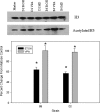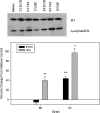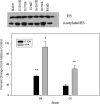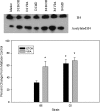Genetic and maternal effects on valproic acid teratogenesis in C57BL/6J and DBA/2J mice
- PMID: 20457659
- PMCID: PMC2905403
- DOI: 10.1093/toxsci/kfq140
Genetic and maternal effects on valproic acid teratogenesis in C57BL/6J and DBA/2J mice
Abstract
Valproic acid (VPA) is used worldwide to treat epilepsy, migraine headaches, and bipolar disorder. However, VPA is teratogenic and in utero exposure can lead to congenital malformations. Using inbred C57BL/6J (B6) and DBA/2J (D2) mice, we asked whether genetic variation could play a role in susceptibility to VPA teratogenesis. Whereas B6 fetuses were more susceptible than D2 fetuses to digit and vertebral malformations, D2 fetuses were more susceptible to rib malformations. In a reciprocal cross between B6 and D2, genetically identical F1 mice carried in a B6 mother had a greater percentage of vertebral malformations following prenatal VPA exposure than F1 mice carried in a D2 mother. This reciprocal F1 difference is known as a maternal effect and shows that maternal genotype/uterine environment is an important mediator of VPA teratogenecity. VPA is a histone deacetylase inhibitor, and it is possible that the differential teratogenesis in B6 and D2 is because of strain differences in histone acetylation. We observed strain differences in acetylation of histones H3 and H4 in both embryo and placenta following in utero VPA exposure, but additional studies are needed to determine the significance of these changes in mediating teratogenesis. Our results provide additional support that genetic factors, both maternal and fetal, play a role in VPA teratogenesis. Lines of mice derived from B6 and D2 will be a useful model for elucidating the genetic architecture underlying susceptibility to VPA teratogenesis.
Figures




Similar articles
-
Embryo transfers between C57BL/6J and DBA/2J mice: Examination of a maternal effect on ethanol teratogenesis.Front Genet. 2014 Dec 11;5:436. doi: 10.3389/fgene.2014.00436. eCollection 2014. Front Genet. 2014. PMID: 25566321 Free PMC article.
-
Cytoplasmic factors do not contribute to a maternal effect on ethanol teratogenesis.Behav Genet. 1999 Jan;29(1):31-9. doi: 10.1023/a:1021485821842. Behav Genet. 1999. PMID: 10371756
-
Contributions of dam and conceptus to differences in sensitivity to valproic acid among C57 black and SWV mice.Reprod Toxicol. 1999 Sep-Oct;13(5):353-60. doi: 10.1016/s0890-6238(99)00038-6. Reprod Toxicol. 1999. PMID: 10560583
-
Valproic acid in pregnancy: how much are we endangering the embryo and fetus?Reprod Toxicol. 2009 Jul;28(1):1-10. doi: 10.1016/j.reprotox.2009.02.014. Epub 2009 Mar 13. Reprod Toxicol. 2009. PMID: 19490988 Review.
-
Valproic Acid in Pregnancy Revisited: Neurobehavioral, Biochemical and Molecular Changes Affecting the Embryo and Fetus in Humans and in Animals: A Narrative Review.Int J Mol Sci. 2023 Dec 27;25(1):390. doi: 10.3390/ijms25010390. Int J Mol Sci. 2023. PMID: 38203562 Free PMC article. Review.
Cited by
-
Sodium valproate in pregnancy: what are the risks and should we use a shared decision-making approach?BMC Pregnancy Childbirth. 2018 Jun 1;18(1):200. doi: 10.1186/s12884-018-1842-x. BMC Pregnancy Childbirth. 2018. PMID: 29859057 Free PMC article. Review.
-
Association of UGT2B7 and UGT1A4 Polymorphisms with Serum Concentration of Antiepileptic Drugs in Children.Med Sci Monit. 2016 Oct 31;22:4107-4113. doi: 10.12659/msm.897626. Med Sci Monit. 2016. PMID: 27795544 Free PMC article. Clinical Trial.
-
Epigenetics and the evolution of form: Experimental manipulation of a chromatin modification causes species-specific changes to the craniofacial skeleton.Evol Dev. 2024 Jan;26(1):e12461. doi: 10.1111/ede.12461. Epub 2023 Oct 18. Evol Dev. 2024. PMID: 37850843 Free PMC article.
-
A proapoptotic effect of valproic acid on progenitors of embryonic stem cell-derived glutamatergic neurons.Cell Death Dis. 2013 Jun 20;4(6):e677. doi: 10.1038/cddis.2013.205. Cell Death Dis. 2013. PMID: 23788034 Free PMC article.
-
The role of neuronal apoptosis in Valproic Acid brain-related teratogenesis: a histochemical and immunohistochemical study in BALB/c mice.Rom J Morphol Embryol. 2020 Jul-Sep;61(3):813-819. doi: 10.47162/RJME.61.3.19. Rom J Morphol Embryol. 2020. PMID: 33817722 Free PMC article.
References
-
- Beck SL. Contributions of dam and conceptus to differences in sensitivity to valproic acid among C57 black and SWV mice. Reprod. Toxicol. 1999;13:353–360. - PubMed
-
- Beck SL. Does genomic imprinting contribute to valproic acid teratogenecity? Reprod. Toxicol. 2001;15:43–48. - PubMed
-
- Boehm SL, Lundahl KR, Caldwell J, Gilliam DM. Ethanol teratogenesis in the C57BL/6J, DBA/2J and A/J inbred mouse strains. Alcohol. 1997;14:389–395. - PubMed
-
- Di Renzo F, Broccia ML, Giavini E, Menegola E. Relationship between embryonic histonic hyperacetylation and axial skeletal defects in mouse exposed to the three HDAC inhibitors apicidin, MS-275, and sodium butyrate. Toxicol. Sci. 2007a;98:582–588. - PubMed
-
- Di Renzo F, Cappelletti G, Broccia ML, Giavini E, Menegola E. Boric acid inhibits embryonic histone deacetylases: a suggested mechanism to explain boric acid-related teratogenicity. Toxicol. Appl. Pharmacol. 2007b;220:178–185. - PubMed
Publication types
MeSH terms
Substances
Grants and funding
LinkOut - more resources
Full Text Sources
Medical
Molecular Biology Databases

